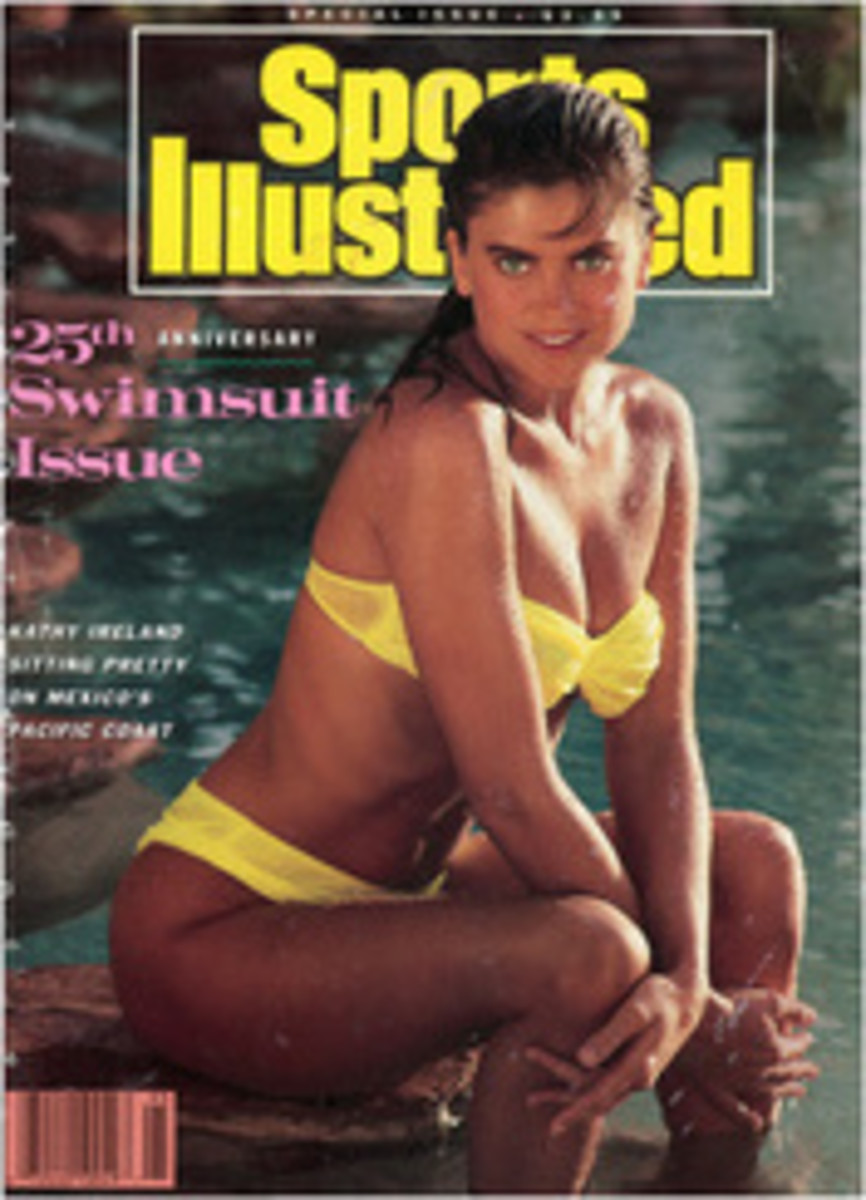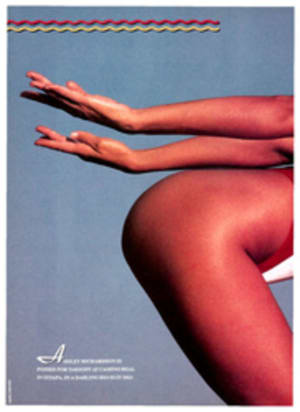
The Pearls Of Paulina
Soft classical music wafts from the stereo as the late-afternoon light streams through the windows of the tiny second-floor Greenwich Village restaurant, accenting its faded elegance. A few souls sit in quiet conversation. It's terribly New York. In a corner Paulina Porizkova relaxes over milk and honey and talks of her movie ventures. She offers this opinion of the film industry: "Basically, it's as rotten and corrupt as modeling."
Welcome to the outrageous mouth of Paulina Porizkova. Such candor is jarring, like cymbals in a chamber orchestra, especially in this sedate setting. But while Porizkova has made it to the top of a scratching, clawing profession largely through an accident of birth that gave her excellent bone structure, she has propelled herself to super-duper stardom by the things she says. In her first interviews after she arrived in this country from France in 1983, she announced, "Modeling sucks." Her tone and tune were set. Today, she has no regrets about her choice of words—she never does—and says, "I'm doing modeling to stay alive. I don't enjoy my work. I don't find it creative. You don't need brains, and there are no heavy qualifications. All it takes is not to be shy and to dare to make a fool of yourself. But I shouldn't complain, because I am privileged enough to be overpaid."
How much she is overpaid is a matter of conjecture. The Ladies' Home Journal said that her contract as the new face for Estèe Lauder gives Porizkova a "reported" $6 million a year. It will be interesting to see if Lauder can put up with Porizkova's sometimes outspoken views. The model shrugs: "They took Paulina, they get Paulina."
Before her exclusive contract with Estèe Lauder, Paulina could earn more than $12,000 a day modeling. And a wealthy foreigner once offered to pay her thousands to hold up a sign at an airport, welcoming him to the U.S. Porizkova doesn't do airports. "I have no idea how much money I make or have," she says. "I have a business manager who flashes the red light. Once a year, somebody tells me how I did, and I say, 'Gee, is that all?' or 'Hey, I'm rich now.' I'm totally dumb about money. But what money does is buy freedom. It gives me the freedom to wait for a good movie part. I don't have to do Sluts in Space. I don't have to sell out."
In 1987 she starred in her first movie, Anna, which caused Vogue to lose control: "The most exciting acting debut of a model since Audrey Hepburn in Roman Holiday." Her second film, Her Alibi, will be released in February. It's a comedy-thriller in which she co-stars with Tom Selleck. She laments the paucity of good scripts. Because most scripts call for you to jump in bed with someone? "No. Because they call for me to be naked, not speak—and jump in bed with someone."
But understand, we are not dealing with a prude here. After all, she once favored wearing a T-shirt that said, more or less, "I've had too much to drink to consider an intimate relationship." The exact wording was substantially coarser. And she is disgusted with herself for having posed nude for GQ magazine: "I did it without thinking. It was a mistake. I'm allowed mistakes. But I learned something. Which is to never do that again."
Porizkova's central charm is her forthrightness. She tucks her legs beneath herself, lights another cigarette, transfixes her questioner with the steady, smoldering gaze seen in a zillion photographs, and says, "I think the way I am is my rebellion against everyone else. I discovered when I was young that I was not like everyone else, and that was great, because it's the people who are different who bring about change and new things."
Repeatedly, she has told interviewers that she has appeared on more than 300 magazine covers. But she admits that, in fact, she has no idea if that's true. "I just read where a model said she had been on 400, and I figured I had been on about as many, so I said 300," says Porizkova. "It was thrilling—the first time I was on a cover. Now it bores me." She was on SI's cover in 1984 and 1985, but says, "I'm sure it helped my career, but then I don't know what would have happened to me without it."
When asked if modeling is important, she says, "Oh, definitely. That and brain surgery. By spotlighting modeling, we are doing enormous things for world peace." And she is convulsed in derisive laughter. "What we also do is create a complex in every woman in America," she says. "Which is easy because no woman ever feels secure about her own looks." Even Porizkova confesses she wishes she had "wider hips, a bigger chest, a more pouty mouth, better-shaped legs. Is that enough? I don't think of myself as gorgeous. For 23 years I've been looking at this same old face. It's not particularly revolting, but on the other hand, I don't say, 'My, what a beauty.' It's just me. It's like if you live with a bunch of Renoirs on the walls, you don't think they are that special. But there is something comforting about my face. It sort of all hangs together."
It wasn't always that way. Born in the working class city of Prost?jov, Czechoslovakia, the three-year-old Paulina was left behind in 1968 when her parents escaped the country on a motorbike just in front of the invading Soviet army. She was cared for by her grandmother while her parents, who had settled in Sweden, campaigned to get the little girl out of Czechoslovakia. Seven years later, after a lot of cloak-and-dagger stuff—and, finally, some successful diplomatic maneuvering—Paulina arrived in Sweden. She was far from cute. "I didn't think I was ugly," she says defensively. "Other people said I was. But I did have a terrible haircut, hideous clothes, glasses. And my ears were a little on the big side. I recall identifying with Dumbo."
When Paulina was 14, a friend in Lund took some photos of her, sent them to modeling agencies, and John Casablancas of the New York-based Elite Model Management saw her promise. So Porizkova moved to Paris, where she modeled by day and ran wild by night, totally unsupervised. Her formal education had ended in the ninth grade. After two years, including her first SI appearance, she moved to New York and lit up that town. Now she lives in Greenwich Village with her boyfriend, whom she steadfastly refuses to name. She has brought her mother and a teenage brother to this country and supports them, along with four other relatives in Sweden. She hopes to open an artist's loft in New York for the use of photographers, sculptors and painters—at no cost. "That's what money is for," she says. "What the hell is the fun of just sitting on a pile of it?"
She dabbles at oil painting and devotes about the same amount of attention to playing her baby grand piano, but swears writing is her true love. She's currently writing a novel about—surprise—a model: "I don't know if anyone else will find what I am writing interesting, but I do." Her favorite pastime: drinking a cup of hot chocolate in front of a fire while reading Bukowski, "which I was doing before he was in PEOPLE." Of her other interests she says, "I am handy at a lot of things but not brilliant at any of them." She insists she moves around New York generally unnoticed, or at least her extreme near-sightedness leaves her with that impression.
She is, in so many ways, disgustingly accomplished (she speaks four languages) and disgustingly normal. For example, she doesn't exercise or diet: "I'm a trash can. I eat whatever makes me happy. I get enough exercise out of life, going to the A & P and carrying those plastic bags home. Besides, making love burns off calories."
She muses over photos of herself: "I don't see me. I see a touched-up version of me. It's the difference between a Christmas tree with the stuff on it and without the stuff on it. I guess pictures are a little bit of a lie."
Then she gathers herself and heads off through the crowds for the A & P. "There are eight million people in New York struggling to survive, to do something with their lives," she says. "I thrive on that energy." A truck driver honks and whistles as she passes.
FOUR ILLUSTRATIONS
PHOTO
PAOLO CURTO
PHOTO
BRIAN LANKER
PHOTO
GREGORY HEISLER
A GREENWICH VILLAGE HAUNT SUITS THE COSMOPOLITAN PORIZKOVA TO A T
PHOTO
GREGORY HEISLER
IF—HARD TO IMAGINE—WORDS SHOULD FAIL, PORIZKOVA CAN ALWAYS DRAW

